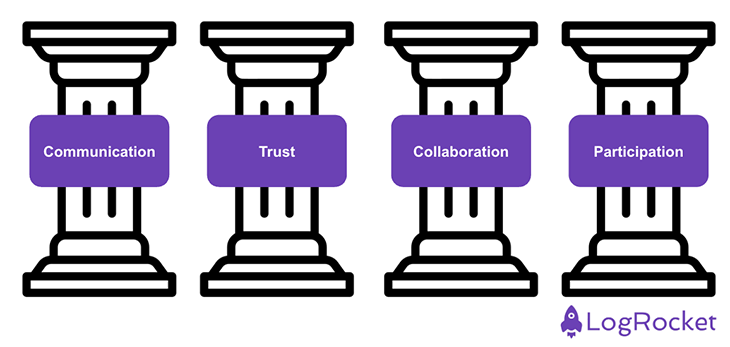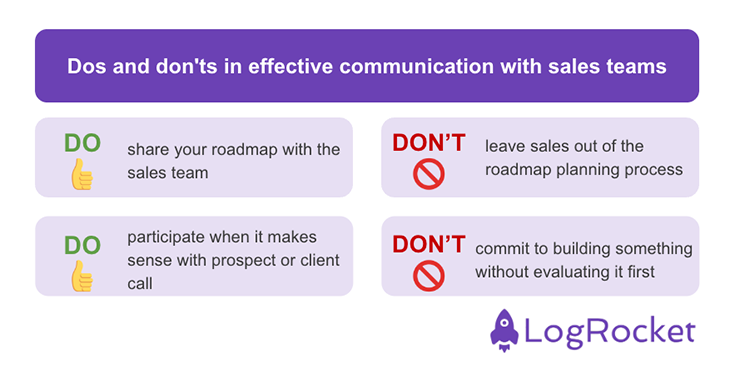As a product manager, it is your responsibility to deliver customer value and provide the best experience possible for your customers.

You cannot achieve these things on your own, however, it takes a village to build and ship amazing products. Having solid relationships and allies across business is absolutely essential to the success of the product and company.
One of the most important relationships is between product and sales teams. Being able to clearly articulate your product strategy to sales — and having them participate and rally around that strategy — leads to everyone winning, including your company and your customers.
In this article, we will dig deeper into what it takes to build a solid relationship with sales and why it is so important to effectively communicate your strategy to sales teams.
We all know that sales sells the product that product management creates. However, the relationship between those two areas isn’t always straightforward. It can be complicated and messy. As a product manager, I can tell you firsthand that sales can be your best friend, worst enemy, or both at times.
The main job of the sales team is to close the sale. Product management’s focus is on adding value to the product through solving customers’ pain points and unmet needs. Sometimes, however, the wires between the two teams cross. This is mainly due to a lack of communication or collaboration — a classic example is if sales doesn’t understand the product strategy and, in an eagerness to win the sale, end up overpromising or committing to features that don’t exist in the product today.
As you can see, this creates big problems for all parties involved. The problem with overpromising up front is that when sales reps sell the future of the product, that future doesn’t always track to the priorities the product team has for their product or feature.
When this happens, the product is in a position to try to fulfill what the sales team member promised in fear of losing the deal, potentially due to unrealistic expectations from the client. This creates a massive headache for both parties and is not the client’s fault, but can be attributed to a breakdown in communication (or a lack of collaboration) and a lack of trusting relationship between sales and product.
On the flip side, the relationship between sales and product can be symbiotic; partnering together to understand client needs and wants, and working on a plan of delivering value in the product. Beautiful!
What does your current situation look like? Do you already have a strong relationship with your sales team? Do they understand the strategy and are they on board with it? If so, congrats, that is amazing and keep it up!
If this is not your current situation, don’t worry! The relationship between both parties and alignment on your strategy can be improved!
Building any relationship takes time, whether that is your relationship with family, a significant other, friends, or teams you work closely with at your job.
Below are four key pillars to fortify your relationship with sales and turn it from a dreaded conversation to a flourishing partnership that’s good for you, your company, and your customers:

How often are you meeting with sales currently? Do you converse with reps on a daily or weekly basis? Less? More?
To build a successful, cross-team relationship with sales, the lines of communication must be open. This can be in the form of working with sales directly on client feedback, casually meeting with sales reps to understand what they are seeing and hearing in the field, and making sure you (the product team) are transparent about your product strategy and vision for the future of the product.
Establishing a trusting relationship between sales teams and product is essential. Regular and open communication with sales on how the product works, what it does and doesn’t do, what your strategy is for the future of the product, and how it compares to the competition all helps sales understand the product and be more confident in their calls with customers.
This regular communication also establishes a layer of trust and understanding. Sales trusts that product teams are making the best decisions for customers and the product, and product teams trust sales to relay that future with prospects and understand where the product is/isn’t headed.
Collaboration serves as the glue to keep the relationship with sales teams together.
By meeting regularly with sales to understand what they are hearing and sharing your thinking on product gaps and future opportunities, you can partner together to build a bright future for the product that you all can rally around.
It is one thing to receive a list of product enhancements or features sales has conjured up from their clients, but it is another thing to be a part of that process. If you are handed a list of wishful enhancements, you are missing the “why” behind them, as well as the urgency.
Also, some of the messages with sales running interference can end up resembling the game of telephone — key pieces will be left out.
Now we’ve established what can go wrong or right in our communication with sales teams. Hopefully, this article has started to jog your brain with ideas on how you can incorporate this with your teams.
Let’s dig a bit deeper into some clear dos and don’ts in effectively communicating strategy with sales:

There are many tools you can use to bring your roadmap transparency out to sales. What works for your organization will greatly vary by culture and size. Simply having regular quarterly calls to review what is on the roadmap is a great place to start.
Have product marketing support? Work with them to curate your message and roadmap for sales that can be shared early with sales teams. You can also explore using roadmapping tools like Productboard which allows people across the organization to review roadmaps and even comment or vote on features they’d like to see prioritized.
As part of your roadmap planning and research, you need to directly involve the sales team. Meet with representatives from that department to get an understanding of what they are hearing in the field, where they are losing or being challenged with deals, or other opportunities. Use this information along with your other research to inform your roadmap.
Hearing feedback from the client firsthand is invaluable. Being able to participate a few times a month in customer or prospect calls can greatly improve not only your relationship with sales but also with your clients and help you build out a stronger, customer-needs-driven roadmap.
So you find out sales sold a huge deal! As part of closing that deal, they promised some hefty product enhancements. Uh oh! Do not panic.
I’d recommend talking with the sales rep to gather more information and, if possible, meeting with the client to unpack exactly what the opportunity or gap is they are looking for a solution to. Remember, just because sales promised something, doesn’t mean that is actually what the customer wants and needs. It’s your job, fellow PM, to figure that out!
Effective strategy communication with sales teams can be tricky, but it doesn’t have to be. Regardless of the state of your relationship with sales today through building communication, trust, collaboration, and participation, that relationship can grow quickly and make a big impact on the products you build and the future success of your company.
Featured image source: IconScout

LogRocket identifies friction points in the user experience so you can make informed decisions about product and design changes that must happen to hit your goals.
With LogRocket, you can understand the scope of the issues affecting your product and prioritize the changes that need to be made. LogRocket simplifies workflows by allowing Engineering, Product, UX, and Design teams to work from the same data as you, eliminating any confusion about what needs to be done.
Get your teams on the same page — try LogRocket today.

A practical framework for PMs to use AI in ideation without sacrificing judgment, strategy, or decision quality.

A practical five minute revenue estimation method to help product managers compare ideas, drop low impact features, and prioritize smarter.

A practical guide for PMs who want to stop being bottlenecks, delegate smarter, and lead teams effectively with a clear ownership framework.

Stop letting unreliable data block features. Treat data as inventory to track quality, ownership, and ship with confidence.